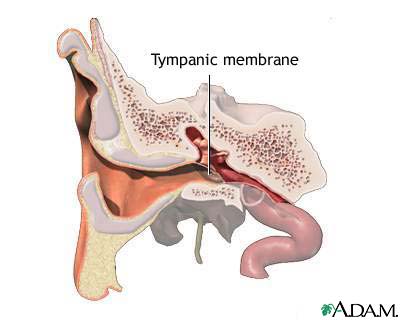Symptoms & Signs
The primary symptom is a sensation that you or the room is moving or spinning. With central vertigo, there are usually other symptoms from the condition causing the vertigo. Symptoms can include:
- Difficulty swallowing
- Double vision
- Eye movement problems
- Facial paralysis
- Slurred speech
- Weakness of the limbs
The spinning sensation may cause nausea and vomiting in some people.
Diagnosis & Tests
A physical exam may reveal:
- Eye movement problems, involuntary eye movements (nystagmus)
- Lack of coordination and balance, difficulty walking
- Hearing loss
- Weakness
Tests to determine the cause of vertigo may include:
- Blood tests
- Brainstem auditory evoked potential studies
- Caloric stimulation
- EEG
- Electronystagmography
- Head CT
- Lumbar puncture
- MRI scan of head and MRA scan of blood vessels of the brain
Pictures & Images
Tympanic membrane
The tympanic membrane is also called the eardrum. It separates the outer ear from the middle ear. When soundwaves reach the tympanic membrane they cause it to vibrate. The vibrations are then transferred to the tiny bones in the middle ear. The middle ear bones then transfer the vibrating signals to the inner ear. The tympanic membrane is made up of a thin connective tissue membrane covered by skin on the outside and mucosa on the internal surface.
-
Vertigo-associated disorders: Overview, Causes
-
Vertigo-associated disorders: Symptoms & Signs, Diagnosis & Tests
-
Vertigo-associated disorders: Treatment
Review Date : 10/30/2008
Reviewed By : David C. Dugdale, III, MD, Professor of Medicine, Division of General Medicine, Department of Medicine, University of Washington School of Medicine; and Daniel B. Hoch, PhD, MD, Assistant Professor of Neurology, Harvard Medical School, Department of Neurology, Massachusetts General Hospital. Also reviewed by David Zieve, MD, MHA, Medical Director, A.D.A.M., Inc.
